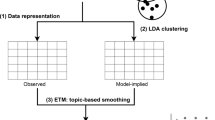Abstract
Evidence-Based Medicine (EBM) gathers evidence by analyzing large databases of medical literatures and retrieving relevant clinical thematic texts. However, the abstracts of medical articles generally show the themes of clinical practice, populations, research methods and experimental results of the thesis in an unstructurized manner, rendering inefficient retrieval of medical evidence. Abstract sentences contain contextual information, and there are complex semantic and grammatical correlations between them, making its classification different from that of independent sentences. This paper proposes a category detection algorithm based on Hierarchical Multi-connected Network (HMcN), regarding the category detection of EBM as a matter of classification of sequential sentences. The algorithm contains multiple structures: (1) The underlying layer produces a sentence vector by combining the pre-trained language model with Bi-directional Long Short Term Memory Network (Bi-LSTM), and applies a multi-layered self-attention structure to the sentence vector so as to work out the internal dependencies of the sentences. (2) The upper layer uses the multi-connected Bi-LSTMs model to directly read the original input sequence to add the contextual information for the sentence vector in the abstract. (3) The top layer optimizes the tag sequence by means of the conditional random field (CRF) model. The extensive experiments on public datasets have demonstrated that the performance of the HMcN model in medical category detection is superior to that of the state-of-the-art text classification method, and the F1 value has increased by 0.4%–0.9%.
Access this chapter
Tax calculation will be finalised at checkout
Purchases are for personal use only
Similar content being viewed by others
References
Richardson, W.S., Wilson, M.C., Nishikawa, J., Hayward, R.S.: The well-built clinical question: a key to evidence-based decisions. ACP J. 123(3), A12 (1995)
Wang, S., Manning, C D.: Baselines and bigrams: simple, good sentiment and topic classification. ACL: ACM, pp. 90–94 (2012)
Hassanzadeh, H., et al.: Identifying scientific artefacts in biomedical literature: the evidence based medicine use case. J. Biomed. Inform. 49, 159–170 (2014)
Kim, Y.: Convolutional neural networks for sentence classification. In: EMNLP (2014)
Conneau, A., Schwenk, H., Barrault, L., Lecun, Y.: Very deep convolutional networks for text classification. In: EACL, Volume 1, Long Papers, pp. 1107–1116 (2017)
Lai, S., Xu, L., Liu, K., Zhao, J.: Recurrent convolutional neural networks for text classification. AAAI 333, 2267–2273 (2015)
Lin, Z., et al.: A structured self-attentive sentence embedding. arXiv preprint arXiv:1703.03130 (2017)
Peters, M., et al.: Deep contextualized word representations. In: NAACL (2018)
Devlin, J., Chang, M.W., Lee, K., Toutanova, K.: BERT: Pre-training of Deep Bidirectional Transformers for Language Understanding. arXiv: 1810.04805 (2018)
Jin, D., Szolovits, P.: Pico element detection in medical text via long short-term memory neural networks. In: BioNLP, pp. 67–75 (2018)
Song, X., Petra, J., Roberts, A.: A Deep Neural Network Sentence Level Classification Method with Context Information. arXiv:1809.00934v (2018)
Lee, J.Y., Dernoncourt, F.: Sequential short-text classification with recurrent and convolutional neural networks. arXiv preprint arXiv:1603.03827. (2016)
Dernoncourt, F., Lee, J.Y., Szolovits, P.: Neural networks for joint sentence classification in medical paper abstracts. EACL 2, 694–700 (2017)
Graves, A., Schmidhuber, J.: Framewise phoneme classification with bidirectional LSTM and other neural network architectures. Neural Netw 18(5), 602–610 (2005)
Gu, J., Lu, Z., Li H: Incorporating copying mechanism in sequence-to-sequence learning. arXiv preprint arXiv:1603.06393 (2016)
Moen, S., Ananiadou, T.S.S.: Distributional semantics resources for biomedical text processing. In: LBM, Tokyo, Japan, pp. 39–43 (2013)
Ding, Z., Xia, R., Yu, J., et al.: Densely connected bidirectional LSTM with applications to sentence classification. In: NLPCC (2018)
Pennington, J., Socher, R., Manning, C.: Glove: global vectors for word representation. In: EMNLP, pp. 1532–1543 (2014)
Amini, I., Martinez, D., Molla, D., et al.: Overview of the alta 2012 shared task (2012)
Dernoncourt, F., Lee, J.Y.: Pubmed 200k rct: a dataset for sequential sentence classification in medical abstracts. arXiv preprint arXiv:1710.06071 (2017)
Kingma, D.P., JimmyBa, J.: Adam: a method for stochastic optimization. arXiv preprint arXiv:1412.6980 (2014)
Srivastava, N., et al.: Dropout: a simple way to prevent neural networks from overfifitting. J. Mach. Learn. Res. 15(1), 1929–1958 (2014)
Ma, X., Gao, Y., Hu, Z., Yu, Y., Deng, Y., Hovy, E.: Dropout with expectation-linear regularization. arXiv preprint arXiv:1609.08017 (2016)
Liu, M.: Feature Stacking for Sentence Classification in Evidence-Based Medicine. Australasian Language Technology Association Workshop, pp. 134–138 (2012)
Xiong, X., et al.: ADPDF: a hybrid attribute discrimination method for psychometric data with fuzziness. IEEE Trans. SMC: Syst. 49, 265–278 (2019)
Xiong, X., Li, Y., Qiao, S.: An emotional contagion model for heterogeneous social media with multiple behaviors. Physica A 490, 185–202 (2018)
Xiong, X., et al.: Affective impression: sentiment-awareness POI suggestion via embedding in heterogeneous LBSNs. IEEE Trans. Affect. Comput. 1–1, (2019)
Acknowledgements
The work was partially supported by the China Postdoctoral Science Foundation under Grant No. 2019M653400; the Sichuan Science and Technology Program under Grant Nos. 2018GZ0253, 2019YFS0236, 2018GZ0182, 2018GZ0093 and 2018GZDZX0039.
Author information
Authors and Affiliations
Corresponding author
Editor information
Editors and Affiliations
Rights and permissions
Copyright information
© 2019 Springer Nature Switzerland AG
About this paper
Cite this paper
Wang, J., Ju, S., Xiong, X., Zhang, R., Liu, N. (2019). A Category Detection Method for Evidence-Based Medicine. In: Tang, J., Kan, MY., Zhao, D., Li, S., Zan, H. (eds) Natural Language Processing and Chinese Computing. NLPCC 2019. Lecture Notes in Computer Science(), vol 11839. Springer, Cham. https://doi.org/10.1007/978-3-030-32236-6_61
Download citation
DOI: https://doi.org/10.1007/978-3-030-32236-6_61
Published:
Publisher Name: Springer, Cham
Print ISBN: 978-3-030-32235-9
Online ISBN: 978-3-030-32236-6
eBook Packages: Computer ScienceComputer Science (R0)





